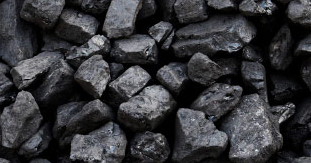Coal - Classification
Classification of coal based on volatile matter and cooking power of clean material.
Coal is a readily combustible rock containing more than 50 percent by weight of carbonaceous material formed from compaction and indurations of variously altered plant remains similar to those in peat.

After a considerable amount of time, heat, and burial pressure, it is metamorphosed from peat to lignite. Lignite is considered to be "immature" coal at this stage of development because it is still somewhat light in color and it remains soft.
- Lignite increases in maturity by becoming darker and harder and is then classified as sub-bituminous coal. After a continuous process of burial and alteration, chemical and physical changes occur until the coal is classified as bituminous - dark and hard coal.
- Bituminous coal ignites easily and burns long with a relatively long flame. If improperly fired bituminous coal is characterized with excess smoke and soot.
- Anthracite coal is the last classification, the ultimate maturation. Anthracite coal is very hard and shiny.
| Class | Volatile matter1) (weight %) | General description | |
|---|---|---|---|
| 101 | < 6.1 | Anthracite | |
| 102 | 3.1 - 9.0 | ||
| 201 | 9.1 - 13.5 | Dry steam coals | Low volatile steam coals |
| 202 | 13.6 - 15.0 | ||
| 203 | 15.1 - 17.0 | Cooking steams coals | |
| 204 | 17.1 - 19.5 | ||
| 206 | 19.1 - 19.5 | Heat altered low volatile steam coals | |
| 301 | 19.6 - 32.0 | Prime cooking coals | Medium volatile coals |
| 305 | 19.6 - 32.0 | Mainly heat altered coals | |
| 306 | 19.6 - 32.0 | ||
| 401 | 32.1 - 36.0 | Very strongly coking coals | High volatile coals |
| 402 | > 36.0 | ||
| 501 | 32.1 - 36.0 | Strongly coking coals | |
| 502 | > 36.0 | ||
| 601 | 32.1 - 36.0 | Medium coking coals | |
| 602 | > 36.0 | ||
| 701 | 32.1 | Weakly coking coals | |
| 702 | > 36.0 | ||
| 801 | 32.1 - 36.0 | Very weakly coking coals | |
| 802 | > 36.0 | ||
| 901 | 32.1 - 36.0 | Non-coking coals | |
| 902 | > 36.0 | ||
1) Volatile matter - dry mineral matter free basis. In coal, those products, exclusive of moisture, given off as gas and vapor determined analytically.
Anthracite coal creates a steady and clean flame and is preferred for domestic heating. Furthermore it burn longer with more heat than the other types.
Typical Sulfur Content in Coal
- Anthracite Coal : 0.6 - 0.77 weight %
- Bituminous Coal : 0.7 - 4.0 weight %
- Lignite Coal : 0.4 weight %
Typical Moisture Content in Coal
- Anthracite Coal : 2.8 - 16.3 weight %
- Bituminous Coal : 2.2 - 15.9 weight %
- Lignite Coal : 39 weight %
Typical Fixed Carbon Content in Coal
- Anthracite Coal : 80.5 - 85.7 weight %
- Bituminous Coal : 44.9 - 78.2 weight %
- Lignite Coal : 31.4 weight %
Typical Density of Coal
- 1100 - 1800 (kg/m3)
Typical Bulk Density of Coal
- Anthracite Coal : 50 - 58 (lb/ft3), 800 - 929 (kg/m3)
- Bituminous Coal : 42 - 57 (lb/ft3), 673 - 913 (kg/m3)
- Lignite Coal : 40 - 54 (lb/ft3), 641 - 865 (kg/m3)
Typical Ash Content in Coal
- Anthracite Coal : 9.7 - 20.2 weight %
- Bituminous Coal : 3.3 - 11.7 weight %
- Lignite Coal : 4.2 weight %



